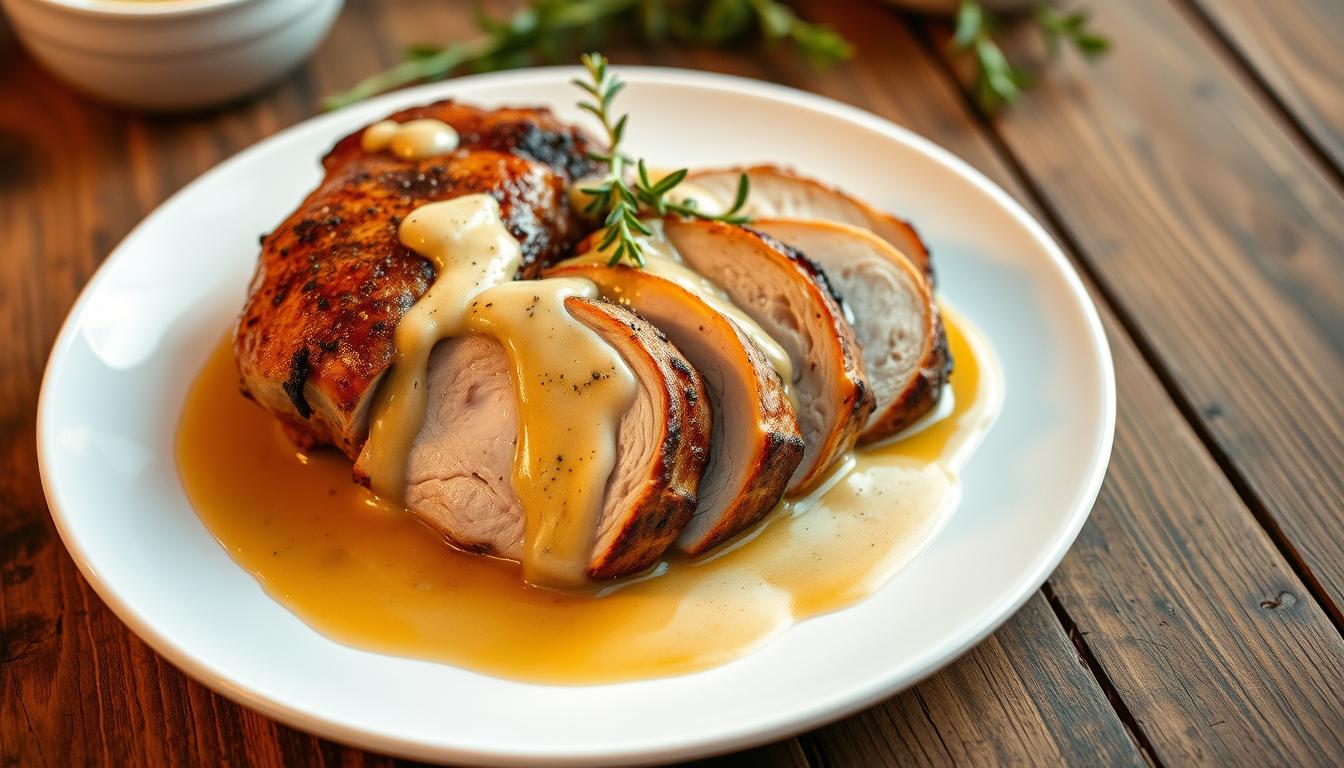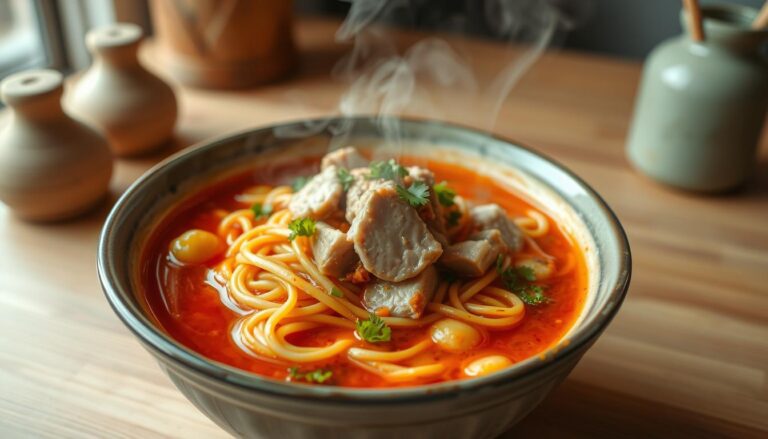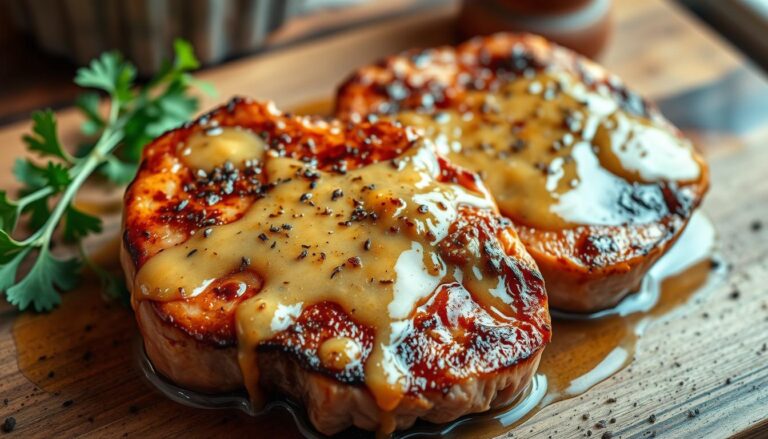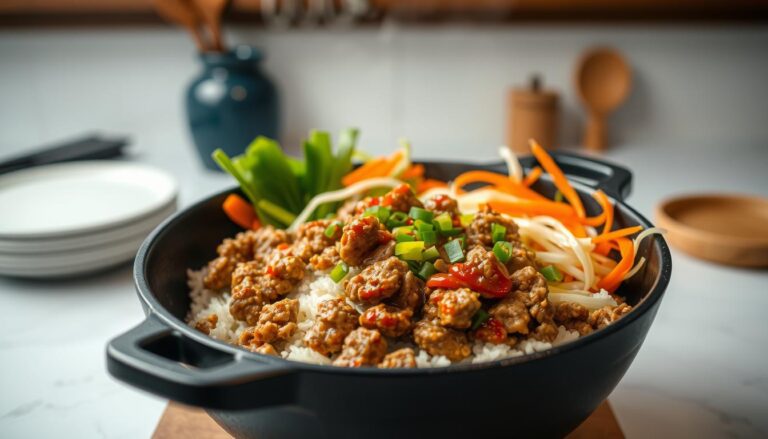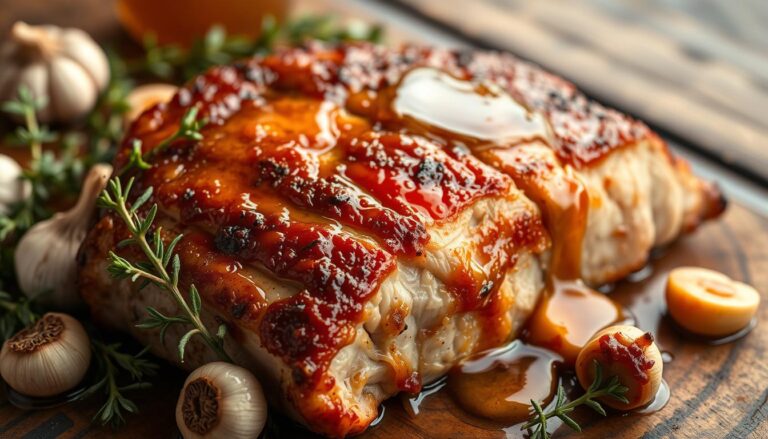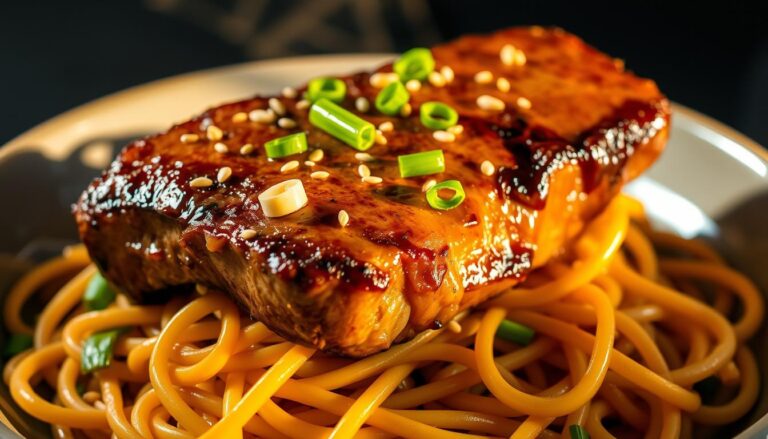How to Cook Pork-Tenderloin-With-Dijon-Sauce-2 – Easy Recipe
Picture this: It’s Friday night, and you’re hosting friends for dinner. You want something impressive but stress-free—a dish that feels gourmet without demanding hours in the kitchen. That’s where this pork tenderloin recipe shines. With just a few simple steps, you’ll create a meal that tastes like it came straight from a cozy French bistro.
This method combines searing to lock in juices and roasting for tender perfection. The star? A velvety Dijon cream sauce that clings to every slice. Whether it’s a weeknight dinner or a holiday like Easter, this recipe adapts effortlessly. You’ll need basics like olive oil, garlic, and fresh thyme—ingredients you likely already have.
What makes this pork tenderloin dijon dish special? It’s all about layering flavors. A quick sear creates caramelized bits in the skillet, which later infuse the sauce with depth. The Dijon mustard adds tang, balanced by rich cream. Serve it with roasted potatoes or steamed greens, and watch your guests reach for seconds.
Key Takeaways
- Master a restaurant-quality meal with minimal prep time
- Learn the secret to perfectly seared meat using a simple skillet
- Create a luxurious Dijon cream sauce in under 10 minutes
- Use a meat thermometer for foolproof doneness every time
- Adapt the recipe for both casual dinners and special celebrations
Introduction to a Flavorful Dinner
There’s magic in simplicity. This pork tenderloin recipe transforms basic ingredients into something extraordinary. Perfect for date nights or Sunday suppers, it delivers restaurant-quality results without demanding chef skills. The secret lies in layering flavors through smart techniques anyone can master.
Recipe Overview and Inspiration
Born from French countryside cooking, this dish balances rustic charm with modern convenience. A golden sear creates caramelized bits in your skillet, while roasting ensures butter-soft meat. The Dijon cream sauce—tangy, velvety, and speckled with herbs—turns simple pork into a celebration-worthy centerpiece.
Why You’ll Love This Pork Tenderloin Dish
Three reasons make this recipe stand out. First, minimal prep time—just season, sear, and roast. Second, flexible timing: cook the pork tenderloin early and reheat gently before serving. Third, that luscious sauce masks any overcooking mishaps, making it forgiving for beginners.
You’ll appreciate how everyday tools like an oven-safe skillet and meat thermometer guarantee success. Fresh garlic and thyme elevate the dish, while pantry staples like olive oil and black pepper form its foundation. It’s the kind of meal that feels special yet never fussy—exactly what busy home cooks need.
Essential Ingredients and Tools
Success in the kitchen begins with the right arsenal. Fresh components and precise tools transform simple recipes into standout meals. Gather these elements first to ensure smooth cooking from start to finish.
Must-Have Ingredients
Two pork tenderloins (1–1.5 lbs each) form the base. Trim excess silver skin for tender results. A spice blend of oregano, rosemary, thyme, onion powder, and cumin adds earthy warmth. High-quality Dijon mustard brings sharpness to balance the cream sauce.
The glaze combines maple syrup, Worcestershire sauce, and soy sauce for sweet-savory depth. For the sauce, you’ll need butter, fresh garlic, lemon juice, heavy cream, and thyme. Use olive oil for searing—its high smoke point prevents burning.
Essential tools include a heavy oven-safe skillet for even heat distribution. A digital thermometer guarantees perfect doneness (145°F internally). Mixing bowls prep spices and glaze efficiently.
Measure spices carefully—too much cumin overpowers. Fresh garlic and lemon juice brighten the sauce. Prep everything before heating your pan. This organized approach saves time and reduces stress.
Prep and Seasoning Techniques for Perfect Pork
Great meals start with smart prep work. Your pork tenderloin’s texture and flavor depend on two critical steps: proper trimming and balanced seasoning. These techniques ensure every bite stays juicy while building layers of taste.
Trimming and Prepping Your Meat
Begin by removing silver skin—the tough membrane on the tenderloin’s surface. Slide your knife under this layer at a 45° angle, pulling gently as you cut. Leaving it on prevents seasoning absorption and creates chewiness.
Pat the meat dry with paper towels. Moisture steams instead of searing, robbing you of that golden crust. Set your oven to 400°F now—it’ll reach temperature as you season.
Crafting Your Signature Spice Mix
Combine 1 tsp salt, ½ tsp black pepper, and ¼ tsp each of oregano, rosemary, and cumin. Add onion powder for sweetness and thyme for earthy notes. This blend adds depth without overpowering the pork’s natural flavor.
Rub the mix vigorously into every side of the meat. Let it sit 10 minutes—this lets the salt draw juices to the surface for better browning. Your skillet should be heating on medium-high during this wait time.
Pro tip: Use olive oil for searing. Its high smoke point handles the heat, while a light coating prevents sticking. Now you’re ready to transform this prepped pork into a masterpiece.
Searing, Glazing, and Roasting for Optimal Flavor
Three cooking stages separate good pork dishes from exceptional ones. Searing builds flavor foundations, glazing adds complexity, and roasting ensures perfect texture. Master these steps to elevate your meal from ordinary to unforgettable.
Perfecting the Searing Process
Heat a large skillet over medium-high until olive oil shimmers. Sear the meat 2-3 minutes per side, rotating with tongs to create an even golden-brown crust. This step isn’t just for looks—it caramelizes surface spices and seals in natural juices.
Why does searing matter? High heat triggers the Maillard reaction, creating rich flavor compounds. Those crispy bits in the pan? They’ll later infuse your sauce with depth. Let the pork rest 5 minutes after searing to redistribute moisture.
Glazing to Lock in Juices and Flavor
Combine Dijon mustard, maple syrup, Worcestershire, and soy sauce in a bowl. Brush this glossy mixture over the pork, coating every ridge. Transfer the skillet to a 400°F oven immediately—the glaze will bubble and adhere as it roasts.
Use a digital thermometer to track progress. Remove the meat at 145°F (63°C) for safe, juicy results. Let it rest 10 minutes before slicing. Pro tip: Double-glaze halfway through roasting for extra flavor penetration.
Crafting a Creamy Dijon Sauce
The sauce transforms this dish from good to unforgettable. After removing the pork from your skillet, those golden-brown bits at the bottom hold the key to rich, layered flavor. This is where your Dijon cream sauce comes alive—a silky blend of tang and richness that ties everything together.
Deglazing the Pan for Maximum Flavor
Return the skillet to medium heat. Melt 2 tablespoons of butter, then add minced garlic. Sauté just until fragrant—about 30 seconds. Pour in ½ cup heavy cream and 2 tablespoons lemon juice, scraping vigorously with a wooden spoon. Those crispy bits dissolve into the liquid, creating a flavor base that’s deeply savory.
Whisk in 3 tablespoons Dijon mustard next. The acidity cuts through the cream while adding a subtle peppery kick. Let the mixture bubble gently for 2 minutes, stirring constantly. This activates the mustard’s complexity without overwhelming the sauce.
Simmering to Achieve the Ideal Consistency
Reduce heat to low. Stir in fresh thyme leaves and a pinch of salt. Simmer uncovered for 4-5 minutes until the sauce coats the back of a spoon. Pro tip: If it thickens too much, add a splash of broth or water. Taste and adjust with extra lemon for brightness or mustard for sharpness.
For best results, strain the sauce through a fine mesh sieve. This removes garlic bits and thyme stems, leaving a velvety texture. Serve warm over sliced pork, letting the sauce pool around each portion.
Mastering pork-tenderloin-with-dijon-sauce-2: Pro Tips and Flavor Enhancements
Transform your kitchen into a culinary studio with these expert strategies. Precision and creativity turn simple ingredients into extraordinary meals—no chef’s hat required.
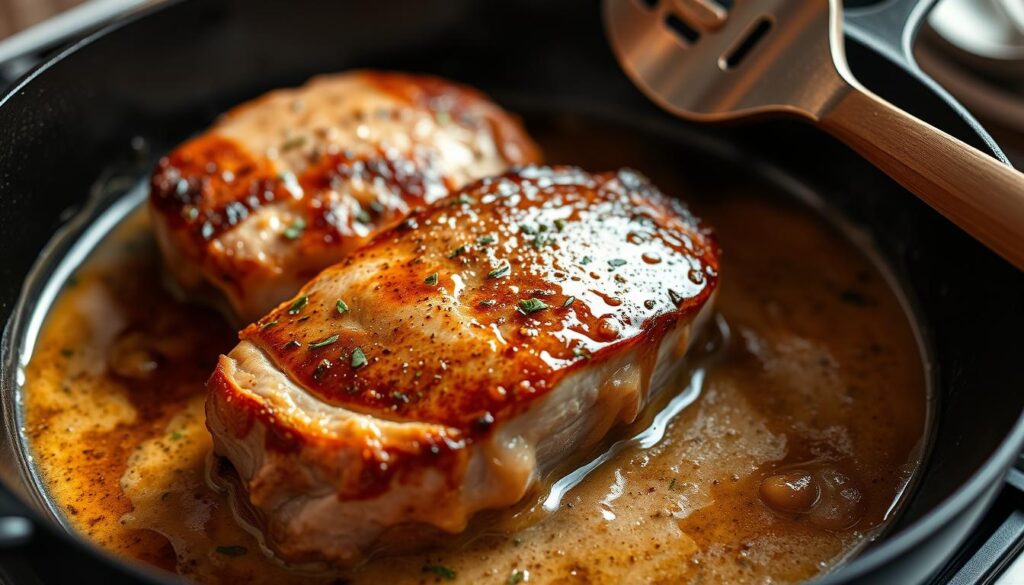
Cooking Techniques and Temperature Guidelines
Your digital thermometer is your best ally. Insert it into the thickest part of the meat, avoiding contact with the skillet. Target 145°F internally—this ensures safety while preserving juiciness. Larger cuts? Add 2-3 minutes per extra inch of thickness during roasting.
Resting matters. Let the pork sit 8-10 minutes after cooking. Why? The fibers relax, redistributing juices evenly. Slice too soon, and those precious liquids end up on your cutting board instead of your plate.
Enhancing Flavors With Herbs and Finishing Touches
Fresh herbs add vibrancy. Try these combinations:
- Rosemary + lemon zest for brightness
- Thyme + cracked black pepper for earthiness
- Parsley + chives for freshness
Stir ½ tsp Dijon into the sauce just before serving—it amplifies tang without overpowering. For a bold twist, mix in 1 tsp prepared horseradish.
“Always taste as you go. Adjust acidity with lemon or richness with butter to balance flavors.”
Finish with a drizzle of resting juices over sliced meat. This simple step adds moisture and ties every element together, creating a cohesive dining experience.
Serving Suggestions and Pairing Sides
What transforms a great entrée into an unforgettable meal? The art of pairing. Your perfectly cooked pork tenderloin deserves companions that highlight its rich Dijon sauce while adding contrasting textures. Let’s explore combinations that turn your plate into a harmonious feast.
Accompaniments That Complement the Dish
Classic pairings never fail. Creamy garlic mashed potatoes soak up the velvety sauce beautifully. Roasted green beans with almond slivers add crunch. For color, try honey-glazed carrots or sautéed spinach with lemon zest.
Lighten things up with a crisp apple-walnut salad. The sweetness balances the mustard’s tang. Steamed asparagus or zucchini noodles work for low-carb options. Pro tip: Add pickled red onions to cut through the sauce’s richness.
Leftovers? Reinvent them. Shred the pork for sliders with horseradish mayo. Toss slices into breakfast frittatas or grain bowls. For quick lunches, layer meat in tacos with cabbage slaw and extra Dijon crema.
Presentation matters. Sprinkle chopped parsley or thyme over the dish. Serve on warm plates to keep everything hot. Mix-and-match sides for different occasions—rustic roasted veggies for family dinners, elegant potato galettes for holidays.
Conclusion
You’ve just unlocked a restaurant-worthy meal that proves gourmet cooking doesn’t require professional skills. This pork tenderloin recipe blends smart prep work with bold flavors—searing creates caramelized depth, while the velvety Dijon sauce adds luxurious contrast.
Remember: trim excess silver skin for tender results, and always use a thermometer to nail 145°F internally. Letting the meat rest ensures juicy slices that hold their natural moisture. Pair with roasted veggies or mashed potatoes to complete your plate.
Feel empowered to tweak herb combinations or sauce thickness to match your taste. Bookmark this method for holidays or busy weeknights—it adapts effortlessly to any occasion. Share your masterpiece in the comments below, and revisit the steps whenever you crave a foolproof crowd-pleaser.
Now slice into that golden-brown crust, drizzle with creamy sauce, and savor every bite. You’ve earned this delicious victory.
FAQ
Can I substitute heavy cream in the Dijon sauce?
Yes, you can use half-and-half or whole milk for a lighter sauce, but the texture will be less rich. For dairy-free options, coconut cream works well without overpowering the mustard flavor.
How do I know when the pork is fully cooked?
Use a meat thermometer to check the internal temperature. Pork tenderloin is safe to eat at 145°F (63°C). Let it rest for 5–10 minutes after roasting; the temperature will rise slightly while retaining juices.
Why does my sauce turn out too thin?
Simmer the sauce longer to reduce it, or add a cornstarch slurry (1 tsp cornstarch mixed with 1 tbsp water) to thicken it. Ensure you scrape all the flavorful browned bits from the pan for depth.
Can I cook this recipe without an oven?
Yes! After searing, cook the pork on the stovetop over medium-low heat, covered, for 15–20 minutes. Flip it occasionally and use a thermometer to confirm doneness.
What herbs pair best with Dijon mustard in this dish?
Fresh thyme, rosemary, or tarragon enhance the sauce. Add them while deglazing the pan or sprinkle chopped herbs over the finished dish for brightness.
How long should I sear the pork before roasting?
Sear each side for 2–3 minutes in hot olive oil until golden brown. This step locks in moisture and creates a caramelized crust for better texture.
Can I prep the pork tenderloin ahead of time?
Yes! Season the meat up to 24 hours in advance and refrigerate it. Let it sit at room temperature for 30 minutes before cooking to ensure even roasting.
What sides work well with this recipe?
Serve with garlic mashed potatoes, roasted asparagus, or a crisp arugula salad. Crusty bread also helps soak up the creamy Dijon sauce.

